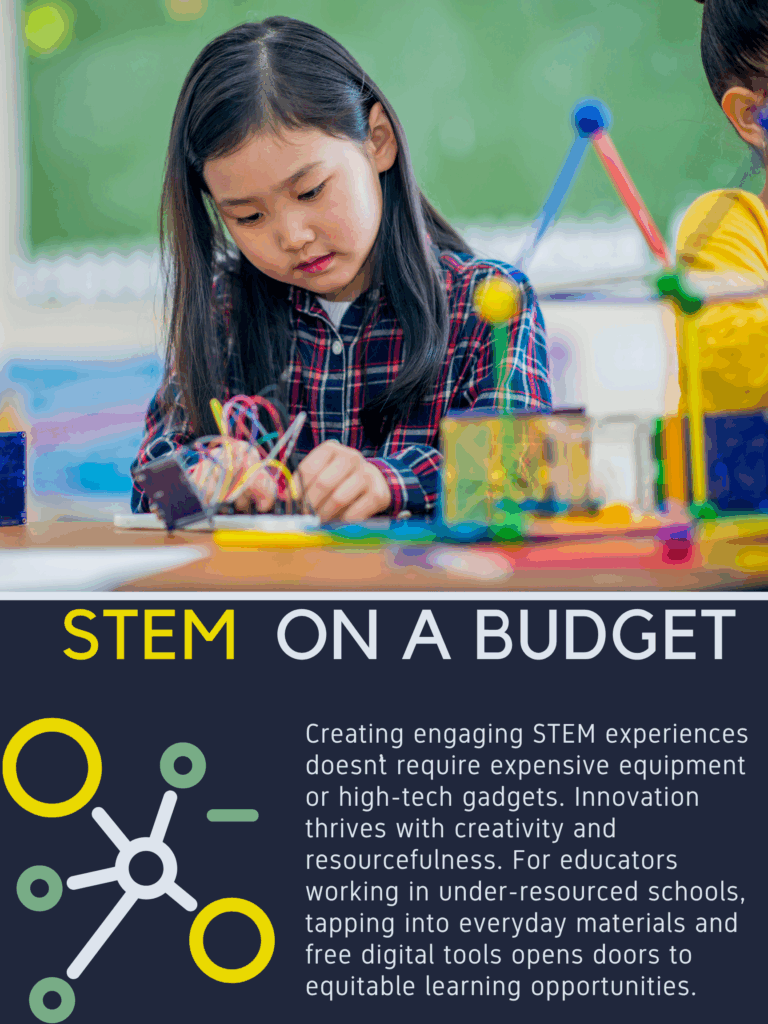
Creating engaging STEM experiences doesn’t require expensive equipment or high-tech gadgets. Innovation truly thrives when fueled by creativity and resourcefulness. For educators working in under-resourced schools, tapping into everyday materials, free digital tools, and community partnerships becomes a powerful strategy to spark curiosity and hands-on learning (Kiyani, Hussain, & Iqbal, 2022). From recycled household items to open-source apps, there are countless ways to design impactful STEM activities that won’t break the bank. This mindset not only supports equity but also empowers educators to make STEM learning relevant and tangible, even when funding is limited.
Simple materials like cardboard, bottle caps, or straws can become the foundation for meaningful engineering challenges. Free digital platforms such as Scratch or PhET simulations provide students with opportunities to explore coding, physics, and scientific modeling in a dynamic way. Research shows that integrating low-cost, self-made STEM materials enhances engagement and learning outcomes, especially in primary and middle grades (Hu, Yang, Cheng, & Chen, 2024). Encouraging students to problem-solve with what’s available nurtures essential 21st-century skills like creativity, collaboration, and resilience (Peterson, 2024). These experiences not only build content knowledge but also promote a growth mindset that students carry into future academic and career pursuits.
By focusing on accessible, low-cost solutions, educators reduce financial barriers while modeling sustainable and inclusive STEM practices. This approach ensures that all students, regardless of their school’s budget constraints, have access to rigorous, exciting learning opportunities. When students see that innovation doesn’t require perfection or expensive tools, they begin to see themselves as capable engineers, scientists, and creators. Partnering with local businesses, libraries, or universities can further extend access to mentorship and real-world resources, strengthening community ties. Ultimately, STEM magic happens when imagination meets intention, proving you don’t need a $5,000 makerspace to ignite passion and meaningful learning.
References:
Hu, C.-C., Yang, Y.-F., Cheng, Y.-W., & Chen, N.-S. (2024). Integrating educational robot and low-cost self-made toys to enhance STEM learning performance for primary school students. Behaviour & Information Technology, 43(8), 1614–1635. https://doi.org/10.1080/0144929X.2023.2222308
Kiyani, M. N., Hussain, Z., & Iqbal, A. (2022). STEM play area project: Low-cost STEM activities using household items for students in underserved community. In ICERI2020 Conference Proceedings. IATED. https://www.researchgate.net/publication/356185792_STEM_Play_Area_Project_Low-Cost_STEM_Activities_Using_Household_Items_for_Students_in_Underserved_Community
Peterson, B. (2024). Formative assessment in hands-on STEM education (Chapter 9). In Integrative STEM Education. IGI Global. https://www.researchgate.net
